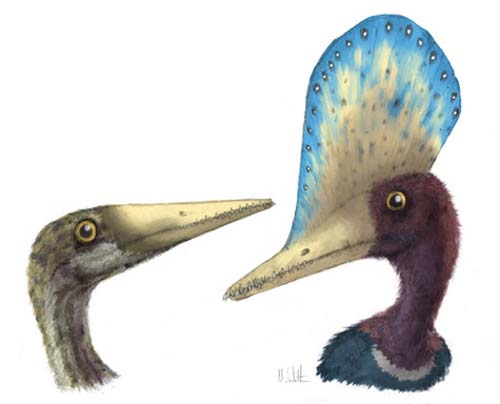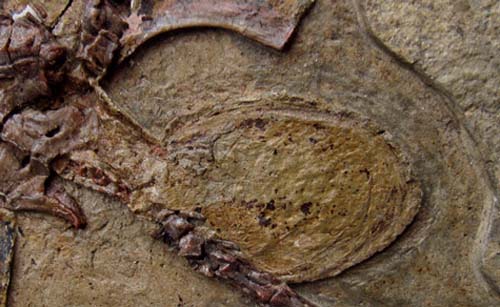Found fossil flying lizard eggs
Archaeologists have just revealed the discovery of nearly complete skeleton fossils of mother-of-lizards with its eggs in China, providing the first direct clues to the sex of flying reptiles. who lived at the same time as dinosaurs, about 220 to 65 million years ago.
Scientist Junchang Lü working at the Chinese Academy of Geosciences said the fossils date back to about 160 million years of the Darwinopterus lizard, the illustration below shows the gender difference. of them.

Lizard-like female and male (right).(Photo: Discovery News)
According to Discovery News Magazine, male flying lizards have a crest with bright colors on their heads that according to scientists, the effect of this crest is to attract female-like lizards during mating season. In addition, females also have wider hips than males, this is a condition that makes it easier for females to lay eggs.
Mother fossil lizard that has wingspan of nearly 1 meter, named ' Mrs. T 'is found in mud sediments in Liaoning province, northeastern China.

Mrs. Fossil's eggsT '.Photo: Discovery News.
According to information published in the online scientific journal of the American Association for the Advancement of Science (AAAS) , fossil analysis shows that it has a tragic outcome, the mother is preparing to lay eggs, then suddenly however, a storm struck and broke its wings and fell into the lake. Under the pressure of the mud layer, the egg finally ' leapt ' out of its mother's body and is preserved to this day.
The analysis said, flying lizards have a close relationship with relatives of crocodiles than birds. The eggshell is quite soft, suggesting that this ancient reptile " buried eggs " and the mother abandoned the egg after laying the eggs and let the eggs absorb the nutrients from the soil like the reptiles today. This shows that there are differences from birds with hard shelled eggs, which contain all the nutrients necessary for the formation and development of young birds.
- Hundreds of 120 million year-old lizard eggs found in China
- Flying lizard eggs 120 million years in China
- Detecting dinosaur fossils with eggs
- 200 million year long sea fossil remains intact
- Detection of prehistoric lizard fossils
- Found fossil lizard 120 million years old
- 9-year-old boy found fossil dinosaur eggs 66 million years
- Detecting sea lizard fossils 75 million years
- What color does flying dinosaur eggs live 66 million years ago?
- Evidence of ancient sharks non-body grabbing the lizard's neck
- Discovered several hundred dinosaur eggs in Europe
- Discovering mysterious flying lizard fossils in China
 Discovered an ancient centipede fossil 99 million years old
Discovered an ancient centipede fossil 99 million years old Discovered bat-like dinosaurs in China
Discovered bat-like dinosaurs in China Discovered a 200-year-old bronze cannon of the coast
Discovered a 200-year-old bronze cannon of the coast Discover 305 million-year-old spider fossils
Discover 305 million-year-old spider fossils